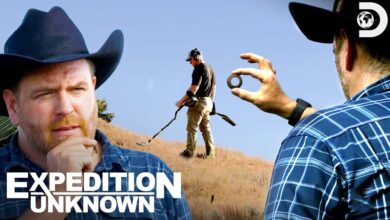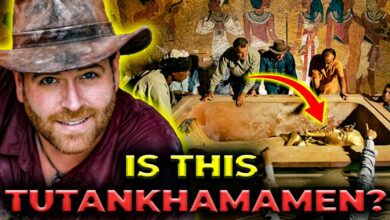Examining the Dead Sea Scrolls | Expedition Unknown
Examining the Dead Sea Scrolls | Expedition Unknown

[Music]
My quest to unlock the mysteries of the
Dead Sea Scrolls brings me to the Holy
Land where the first chapter in the
history of the scrolls was written: the
old city of Jerusalem.
It may sound like a cliche, but there
really is no place like it. Choose any
descriptor you like: evocative, maddening,
overwhelming, divine. You don’t walk these
streets, you’re carried through them. To
step off the curb here is to be swept up
in the turbulent waters of history.
[Music]
It’s been a crossroads of civilizations
as long as there have been roads to
cross. It was the center of trade routes
stretching from Rome to India and home
to diverse cultures living side-by-side,
sometimes in harmony and sometimes in
conflict. But more than anything else,
Jerusalem is about faith, home to three
of the holiest places on earth: the
golden Dome of the Rock, sacred to
Muslims; the Church of the Holy Sepulchre,
the site of the crucifixion of Christ;
and the oldest of them all, the Western
or Wailing Wall, all that remains of a
3,000-year-old Jewish temple.
To understand what was once here, we have to
turn back the hands of time. The
so-called Temple Mount begins as a
natural rise known as Mount Moriah, where
ancient Hebrews believed creation itself
began. Over time, a Jewish empire grows
around it. The Great Temple of Solomon is
built on the sacred mount in 586 BCE.
It’s destroyed by invaders.
The rebuilt structure is known as the
second temple, the center of Jewish faith
and home to Jerusalem’s greatest
treasures, including an archive of sacred
scrolls and manuscripts.
Centuries later, the Romans conquer the city. In the year
67, the Jews of Jerusalem spark a
rebellion. In retaliation, the Roman army
destroys the second temple. Now all that
remains is the western wall of the
temple platform. The story of the Dead
Sea Scrolls begins when Jerusalem looked
like this.
[Music]
I’m at the Israel Museum’s scale model of
the holy city to meet scroll expert and
curator Dr. Adolfo Reutemann.
Alright, let’s talk about this incredible model
here. I feel like Godzilla. This is awesome!
This is the Jerusalem of the first century
CE, in the time of the Romans. So we are
kind of in the period of the Dead Sea
Scrolls here?
Exactly. The world discovered in a place called Qumran,
located on the northwestern shore of the
Dead Sea, about 30 miles from Jerusalem.
Okay, the first dates were discovered by
the end of 1946 or the beginning of 1947.
Amazingly, they were discovered
completely by accident. As the story goes,
a young shepherd is herding goats in
Qumran near the Dead Sea. Passing a cave,
he throws a stone to scare a wayward
animal back to the flock, and here’s
something shatter.
Curious, he enters the cavern and
discovers 10 clay jars holding seven ancient scrolls.
They had no idea they’d discovered maybe the most
significant archaeological treasure of
the 20th century. They decided, why not sell
the scrolls? Four scrolls were bought by
a dealer from Bethlehem, an Arab Christian,
and the other three a Hebrew University
professor bought for the Hebrew
University. So, on both sides of
Jerusalem, a Jew and a Christian had
scrolls.
Okay, this is the beginning of a joke, but instead of walking into a
bar, the Christian antiquities dealer
resells his scrolls to the archbishop of
the Syrian Orthodox Church. Facing
political turmoil in Jerusalem, the
archbishop smuggles the scrolls into the
United States in 1954. He takes out a
classified ad in The Wall Street Journal,
offering the scrolls to the highest
bidder. Israeli scholars race to acquire
them, sensing their huge historic and
religious value. The scrolls were bought
for the State of Israel for a quarter of
a million dollars in ’55.
The sale sets off a flurry of digging
and looting along the edge of the Dead
Sea that eventually yields the remains
of more than 900 manuscripts, discovered
in 11 different caves. Now we have around
20,000 fragments of manuscripts.
Unbelievable!
We’d like to see them.
I would love to see them. Come with me.
Dr. Reutemann invites me into the
hallowed halls of the so-called Shrine
of the Book, where the world’s greatest
collection of scrolls is carefully
preserved. We pass through a series of
chambers inspired by the caves where the
scrolls were discovered, and at the end
of the tunnel, a revelation.
This place—what a room! It feels like you’re in a
temple, a shrine. Here, in this venerated
vault, I’m surrounded by a treasure trove.
The remains of some of the best-preserved
Dead Sea Scrolls are on display, amazing.
Primarily in Hebrew, on parchment or papyrus.
The first question is: what’s written on them?
Let’s start with the Mona Lisa of all the spoils:
the Book of Isaiah. Unbelievable!
Written about 2,000 years ago, this
scroll is the oldest known copy of a
major portion of the Old Testament or
Hebrew Bible.
So this is just a piece of it?
How long is the full scroll?
More than 20 feet long. These monasteries pass
all the 66 chapters of the Book of
Isaiah.
Before this was found, what was the
oldest known copy of the Book of Isaiah?
From the Middle Ages—thousand years after
this manuscript.
This ancient copy of Isaiah is a big deal to biblical
scholars, since it confirms that this
part of the Old Testament has remained
consistent for thousands of years.
But not all of the Dead Sea Scrolls are
copies of the Bible as we know it. We
have apocryphal stories, new stories that
we didn’t know before the discovery of
the scrolls.
A digital document is called the War Scroll.
These describe the war of the end of history
between the son of lies and the son of
darkness. That’s very Game of Thrones!
But this doesn’t appear in the Old
Testament.
No, it’s outside.
Scholars believe that the War Scroll is more than just
a description of the apocalypse; it was
a tactical manual outlining weaponry and
maneuvers to help good triumph over
evil.
And it’s not the only scroll with
stories that can’t be found anywhere
else in Scripture. We have a new version
of the Book of Genesis. Abraham is
presented as an exorcist, expelling
demons. Amazing!
In this reimagining of Genesis, Abraham
doesn’t just speak with God—he possesses
divine powers. This is a new presentation
of Abraham. Very new.
The thing that is so mind-blowing is that
the ink looks like it was written
yesterday.
Yes, but most of the scrolls, they don’t look like this.
Some of them are in very good shape,
some others are very fragmentary.
The work at the lab is crucial in order
to preserve them, to learn what other
secrets are hidden on the scrolls.
Dr. Reutemann helps arrange exclusive access
to the only laboratory in the world that
actually handles the original manuscripts.
Very nice to meet you.
For 70 years, the Leon Levy Laboratory of
the Israeli Antiquities Authority has been
doing the miraculous work of making these
ancient parchments readable again.
Thank you for having me here. This is
incredible.
Pnina reveals one of the crown jewels of
their restoration work, allowing me to
see a scroll as its author did—without
the barrier of museum glass.
This is the Big Hospital forum, cave 11. Now,
don’t breathe.
[Music]
Not a problem, because getting this close
to an original scroll literally takes my
breath away. It’s mind-blowing.
Is there an older copy of the Book of
Psalms than what we’re looking at right
here?
No. How crazy is that?
Now, we’ll show you the scroll that
drives the world crazy.
Of all the copies of the Book of
Deuteronomy that we have, this is the
only copy that preserves all of the Ten
Commandments.
Wait a minute! This is our oldest source
for the complete Ten Commandments?
Yes.
And is the text complementary with
later versions? Are there any changes?
There’s a slight difference.
[Music]








